
|
TI-TIGON, TI-LIGER (TIG-LIGER), LI-TIGON, LI-LIGER |
TI-TIGON, TI-LIGER (TIG-LIGER), LI-TIGON, LI-LIGER
Female tigons and ligers are often fertile and can mate with a lion, tiger or in theory with another species such as leopard or jaguar. Tigers and ligers have been mated together to produce ti-ligers (tig-ligers). Tigers and tigons have been mated to produce ti-tigons (below). Ti-ligers and ti-tigons are more tigerlike (75% tiger). Ti-tigons resemble golden tigers but with less contrast in their markings. Lions and ligers have been mated together to produce li-ligers. Lions and tigons have been mated to produce li-tigons. These hybrids are more lion-like (75% lion). (See also Backcrossing for information.)
Male hybrids are rarely, if ever, fertile even if they do display sexual behaviour. To date, all male ligers, tigons, ti-tigons and li-tigons investigated have apparently proven sterile. There are no authenticated liger x tigon, liger x liger or tigon x tigon hybrids. Theoretical offspring could be lion-like, tiger-like, liger-like or tigon-like, depending on what combination of genes they inherited. It is more likely that anecdotally reported offspring from supposed hybrid-to-hybrid matings actually resulted from unobserved additional matings of a hybrid female with a pure-bred lion or tiger.
Many mid-to-late 20th century zoos claimed to have the first li-ligers, ti-ligers, li-tigons or ti-tigons in the world, but such hybrids had already been bred in the 19th century in menageries and circuses (mostly in the USA).

LI-TIGON
According to "Wild Cats Of The World" (1975) by Guggisberg, ligers and tigons were long thought to be sterile: "In 1943, however, a fifteen year old hybrid between a lion and an 'Island' tiger was successfully mated with a lion at the Munich Hellabrunn Zoo. The female cub, even though very delicate, was raised to adulthood." Prior to this all lion-tiger hybrids were believed to be sterile (even though other hybrid females such as jagulep females were already known to be fertile). 1943 seems to be the first recorded instance of a second generation hybrid of tiger and lion. This female tigon produced nine cubs in five litters between 1948 and 1950.
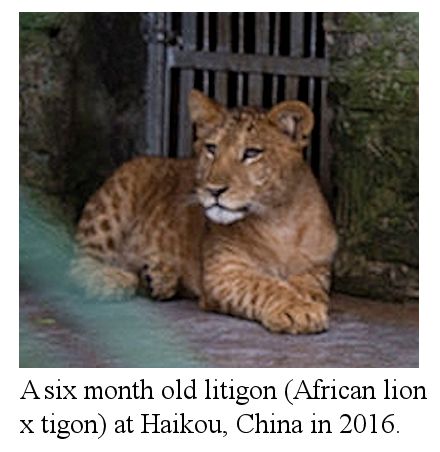
On 18 January 2017, two litigon cubs went on public display at a safari zoo in Haikou, China. Their mother was a tigon and the father was an African lion.
In 2017, Shubhobroto Ghosh (of World Animal Protection in India, New Delhi, India), contacted me with information and photos about a hitherto forgotten litigon The litigon rediscovered . A photo of this animal had been found in the Guinness Book of Records 1985 by Dr Karl Shuker. Earlier, in July 2016, while scouring through the archives of the National Library in Kolkata, India, Payel Biswas, Librarian at the Institute of Urban Transport (India), New Delhi and Subhodip Bid of the National Library, Kolkata found a report Litigon has taken after its sire in The Statesman newspaper of 12th March (1980). It included a photograph of a male litigon. The report described this as a hybrid of a male Asiatic lion a female tigon (hybrid of a male tiger and a female African lion) bred at the Alipore Zoological Gardens in Calcutta (now Kolkata). The litigon was named Cubanacan by Jose Lopez Sanchez, the then Cuban Ambassador to India, and was photographed on its first public appearance. Until the rediscovery of the news report, this second-generation hybrid seems to have been forgotten.
Cubanacan grew to be one of the largest ever big cats of the time, weighing around 363 kg (800 lbs), and measuring 3.5 m long and 1.32 m wide at the shoulders. He was born during 15 years of hybridisation attempts between 1964 and 1979 at the Alipore Zoo. The zoo reportedly produced its first hybrid cat, a tigon called Rudrani, on 13 October 1972 in the sixth litter of a female African lion Munni and a male tiger Munna. A second tigon, Rangini, was born on 8 March 1974 and died in 1999, making him the oldest known tigon. Both tigons were named by the then Chief Minister of West Bengal, Siddhartha Shankar Ray. Rudrani was subsequently mated with a male, lion, initially reported to be an Asiatic lion, but now known to be an African/Asiatic hybrid, called Debabrata, resulting in Cubanacan, the only surviving litigon in a litter of three (one littermate wa stillborn and the other died a day after birth), Cubanacan. Cubanacan was the most famous of five surviving litigons out of the seven produced. Alipore was the only zoo in India to have tigons and the only one worldwide to have successfully bred litigons. Cubanacan died on 12 April 1991. The zoo subsequently tried, unsuccessfully, to breed further litigons. Rudrani ultimately produced seven offspring altogether, five of which survived (a survival rate of 71.42%). Accirding to Shubhobroto Ghosh, litigon Piyali was born in a litter after Cubanacan, 22nd March, 1982, and Merina was probably in the same litter.
Merina, one of the later litigons, had an uncanny habit of looking straight into the eyes of visitors whilst lying down. Shubhobroto Ghosh experienced this with her on more than one occasion. She was housed in a cage in a series of enclosures called 'The New Small Carnivora House.' According to the Bartaman (Bengali daily) report on litigons after the publication of "The litigon rediscovered" was published, the last Alipore Zoo litigon died in 1997.
So how did Cubanacan and his kin come to be created and then forgotten? In 1985, the Indian government banned big cat hybridisation experiments. Efforts were made to obliterate references to the hybrids bred at Alipore Zoo. Very few official records of its big cat experiments exist today, possibly a result of the ban on hybridisation attempts. These experiments did establish that hybrid tigons are fertile and can produce viable offspring. According to an official report Lion, tigon match-up fails to show spark (Toledo Blade. p. 22, 31 October 1976) Attempts are afoot to induce companionship between Rudrani and an Indian lion called Devavrata. Signs of mutual acceptability are discernible and should compatibility result perchance, birth of a triple hybrid may not be that improbable as believed so far. Amarendra Nath Guha, then Director of Alipore Zoo, was quoted in a newspaper as saying, (Cubanacan was) an ambitious hybrid of a type believed to be improbable so far.
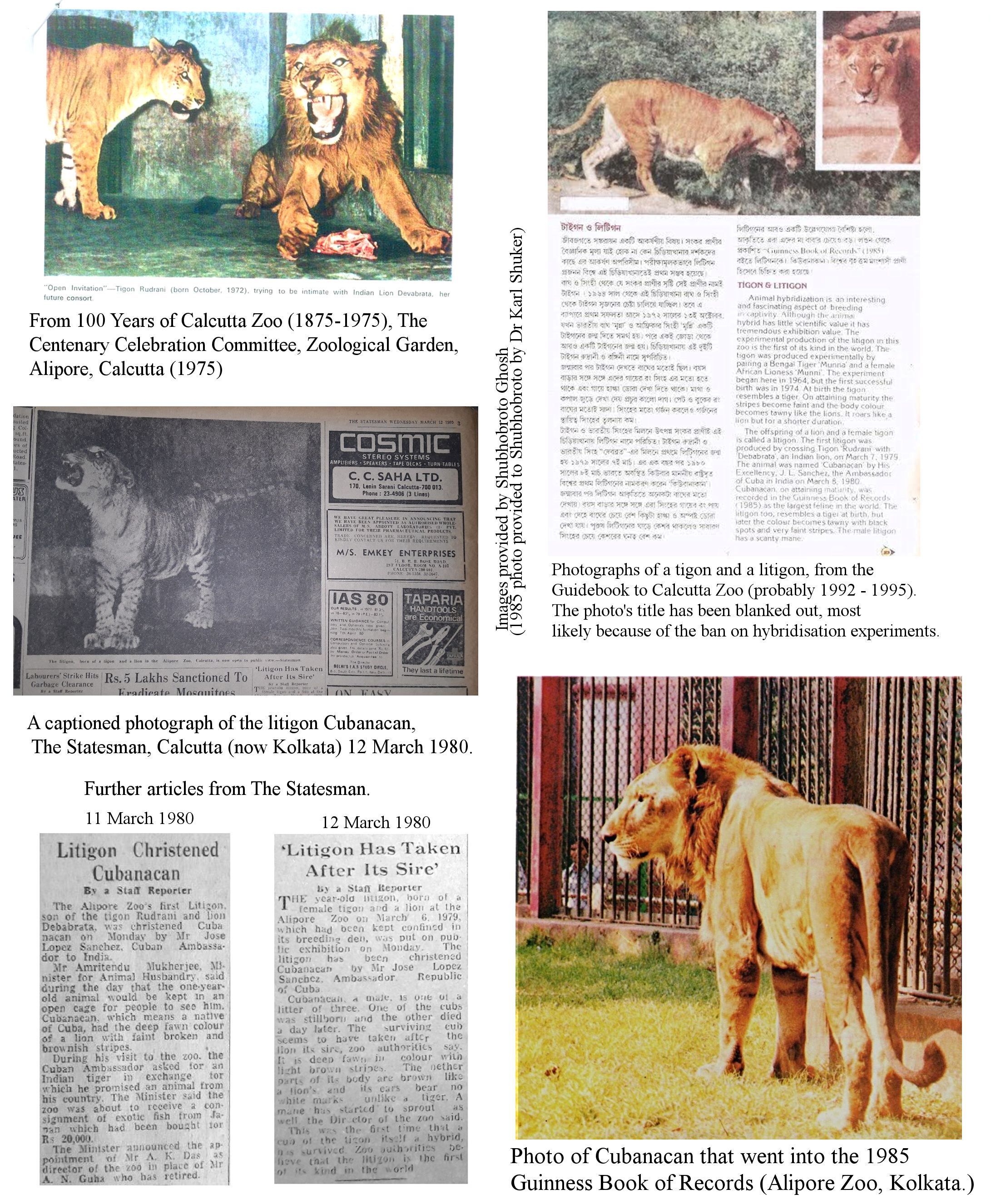
The historical photographs below, purporting to be Cubanacan, with Josip Marcan are not Cubanacan. Marcan was never Cubanacan s handler and Cubanacan never went outside of Alipore zoo or performed any circus tricks. The images are more likely to be a liger. Assistant Director of Alipore Zoo, Mr Sushanta Bhattacharya, handled the cat when he was measured for his Guinness record but there were no circus tricks involved. Cubanacan was reported to be extremely docile to the extent that he did not resist people measuring him manually. A Bengali newspaper did a story on the Litigons of Alipore Zoo after Shubhobroto Ghosh et al s paper was published in Nature India online in April, 2017.
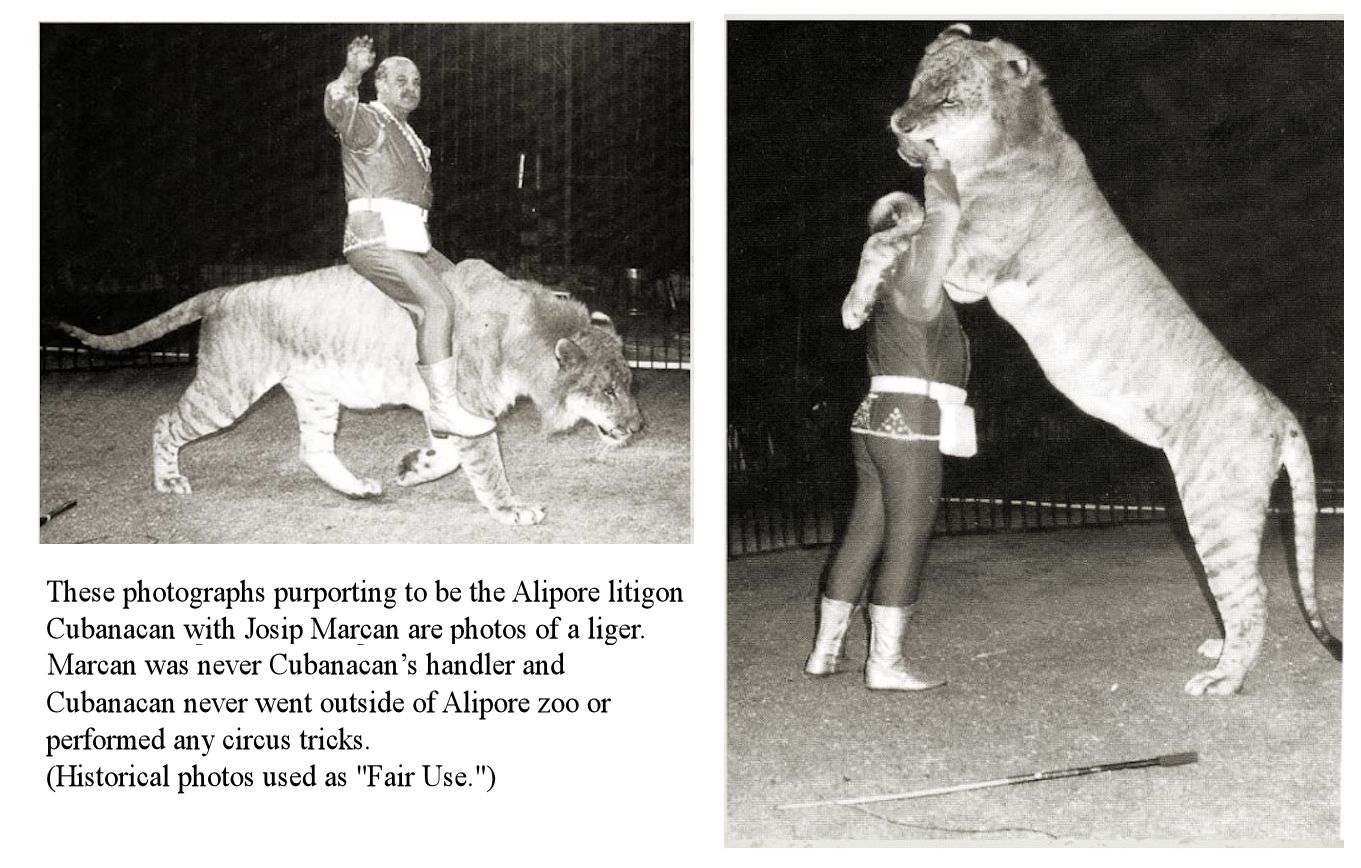
This photo of tigon Rudrani with her litigon kitten (her fifth litter) is from an article by Shubhobroto Ghosh in Desh magazine in Bangla, a premier publication known as the "New Yorker Of Kolkata," dated 17 February, 2025. The article is a history of the Alipore Zoo in Kolkata. It is believed to be the only photograph in the public domain where one can see a tigon(tiger x lion) and a litigon ([lion x tigon(tiger X lion)] in the same frame. The photograph is on page 7 and is dated 3rd July, 1984; it was taken by Dilip Banerjee of Anandabazar Patrika, a Bangla newspaper published from Kolkata that now has a readership of over 1.5 million readers every day.
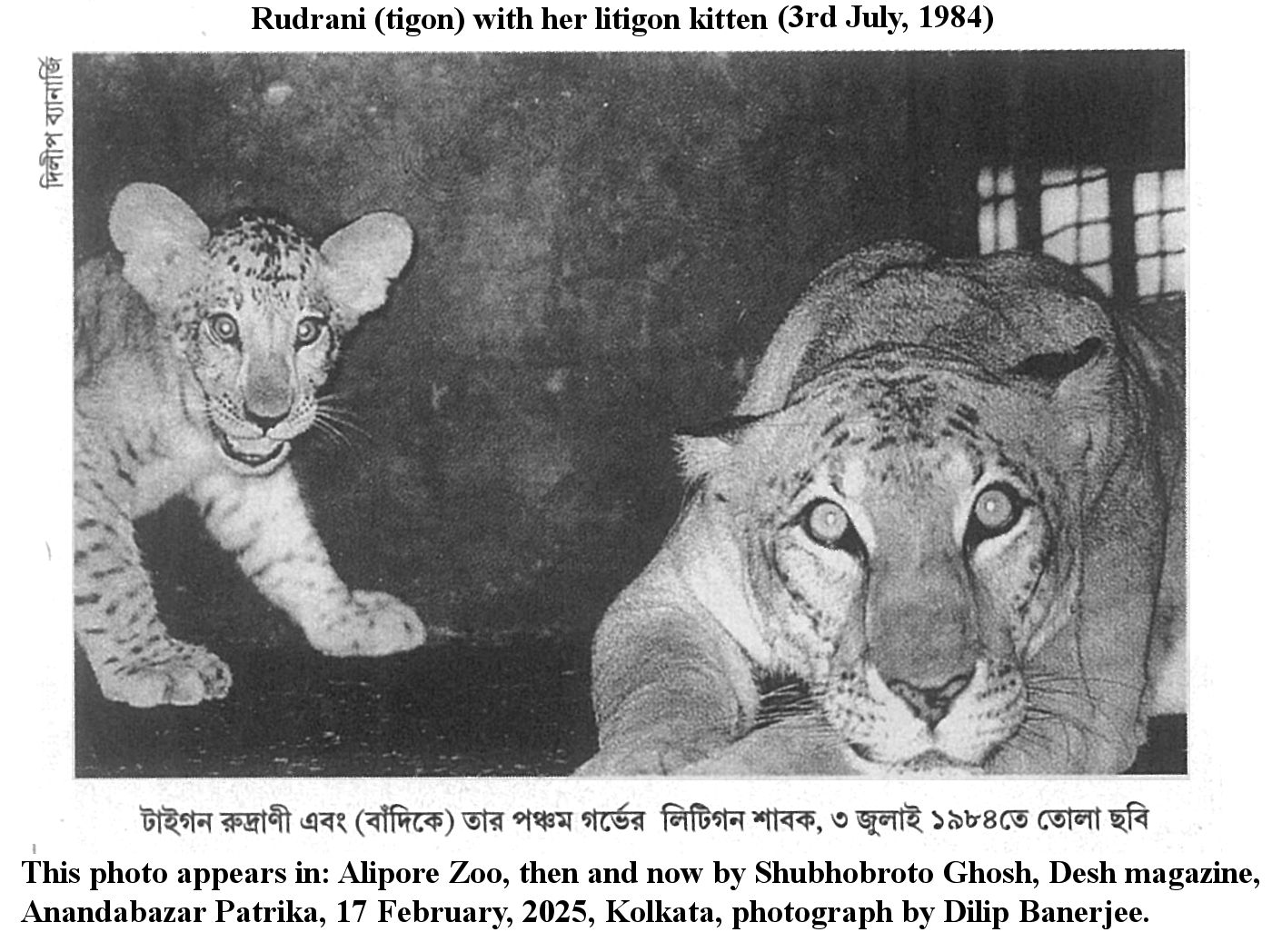
TI-TIGON
During the late 1970s/early 1980s, the Shambala Preserve had both a tigon and a ti-tigon. The full illustrated story of Noelle the tigon and Nathaniel, her ti-tigon son, is detailed in "The Cats of Shambala" by Tippi Hedren (also an article by V Junger, People 11:90-1 Jan. 22, 1979.). On Christmas morning 1978, handler Brad Darrington found a 1 lb striped female cub hidden behind the den box in Nikita's compound. Nikita was the preserve's 600 lb tiger who ruled a pride of 9 lionesses. The cub was believed to have be born to Debbie, a lioness that had arrived from LA Animal Control as an orphan in 1974. None of the lionesses was thought to have been pregnant, though they did sometimes give birth surreptitiously. Debbie rejected the cub. The was named Noelle and was hand-reared. At 5 days old, Noelle began making the nasal, puffing "ff-fuff" sounds of the tiger as well as the happy "aa-oow" of a lion cub. While tiger cubs dislike being held or cuddled, Noelle had the cuddly nature of a lion cub. Her nose was tiger-like rather than blunt like a lion. At about 2 weeks old, Noelle was diagnosed with septic arthritis which caused her to limp. At the time of Noelle's birth, Hedren knew of only 3 other tigons in the US.
Being such a rarity, Noelle was widely photographed and her image appeared in magazines and articles around the world. At the age of 4 years, she was a little larger than the average lioness, being taller and longer-legged. Standing on her hind legs she measured 13 ft from tail tip to nose tip. Her stripes were brown, rather than black, on an orange background colour with a white belly. She had mottled spots on the top of her head. Her vocalisations were lioness-like rather than tigress-like and she had the sociable nature of the lion combined with the playfulness and love of water of the tiger. She also inherited an excellent jumping ability, easily making 10 ft vertical leaps.
Noelle was housed with 3 other tigresses and a 5 year old Amur (Siberian) tiger called Anton. Although the other lionesses and tigresses at the preserve were put on the contraceptive pill, Noelle was wrongly assumed to be sterile because she was a hybrid. She therefore came on heat regularly and mated with Anton from spring 1982 onwards. When Noelle displayed signs of pregnancy, it was assumed to be a false pregnancy (hormonal/psychological), however, on September 16th, 1983, she gave birth to a single small male cub. Noelle and the cub had to be separated from the other females who were attempting to kidnap the cub, wounding it in the process. The cub was named Nathaniel, this being derived from Tippi's birth name of Nathalie. Nathaniel was possibly the only ti-tigon in the world at the time.
|
Left: Female tigon and her male ti-tigon offspring sired by a Siberian tiger. The ti-tigon is 75% tiger and more tiger-like than his mother. Right: Male tigon showing pale striping and lion-like mane. |
|
Being 75% tiger, Nathaniel was more tiger-like than his mother. He had clearly defined darker stripes and facial markings and his coat that was unusually long and thick. Nathaniel "spoke" tiger rather than a mix of lion of and tiger. Instinctively Noelle "spoke" tiger to her cub. When Nathaniel was 6 weeks old, it became necessary to remove him from Noelle in order to imprint him on humans since Shambala's big cats were trained for films. From then on he was hand-reared although after several months, he was reintroduced to Noelle who began to teach him big cat manners. Being only 25% lion, Nathaniel did not grow a mane although he did achieve an impressive size. He died age 8 or 9 years old due to cancer. His tigon mother, Noelle, also developed cancer and died not long after. It is possible that the mix of genes contributed to the illness.
LI-LIGER
H Hemmer (1966) described the offspring of a female liger and a male lion (li-liger) as being smaller than a normal lioness. Its tiger markings were barely recognisable in summer, but were somewhat plainer in the winter coat. The progeny of female ligers mated to lions have also been described as resembling young lions.
On April 24, 1984, The Times reported the birth of a "tigron" (ti-liger or li-liger) at the tiger park in Thoiry near Paris. The park was owned by Vicomte Paul de la Panouse who allowed lions and tigers to roam freely together; so freely they interbred. The Vicomte got into the liger business because of the habit of lionesses and tigresses of killing or neglecting their cubs. On April 17, a female "ligron" (liger) called Julie gave birth to the cub. Julie was one of 4 liger offspring from a lion called "Bichon" and 2 tigresses called "Les Mechantes" (the naughty/nasty ones). The ligers were hand-reared. The father of Julie's cub is believed to be either her father Bichon (resulting in a li-liger) or her half-brother, Patchwork (ligron/liger). It was reported that in 1984 2 "ligrons" (ligers) mated and produced offspring, thus disproving that hybrids were sterile (The Gazette, Montreal, Quebec, May 14, 1988. p I3 ); but the sire of the 2nd generation was probably Julie's own sire, a lion.

In 2012 and in May 2013, a female liger called Zita at Novosibirsk, Russia produced 2 litters of li-liger cubs sired by an African lion called Sam. The second litter comprised three female cubs. Their baby coats are heavily marked with evenly spaced vertically elongated black rosettes, and black spots on the face and limbs and a spotted and ringed tail. The alignment of the darker markings are due to their tiger heritage.
"LILIGER" BORN IN RUSSIA NO BOON FOR BIG CATS, National Geographic, 12th September 2012.
[. . .] a Russian zoo has released photos of a so-called "liliger" named Kiara, the offspring of a liger mother and a lion father. The cub, born last week at Novosibirsk Zoo, may be the only liliger in existence. But charming as the cuddly cub appears, ligers, liligers, and other mix-and-match felines raise serious concerns for advocates of big-cat conservation. Ligers are the result of a male lion mating with a female tiger. Craig Packer, director of the Lion Research Center at the University of Minnesota, said he hasn't heard of a liliger before but is "not surprised" that it exists. All ligers are born in captivity, Packer said, because this animal simply does not exist in the natural world. Not only are wild lion and tiger populations separated by geography, there are certain behavior mechanisms in place that would prevent the two species from mating.
"If a tiger tried to mate with a female lion it would be chased away by the other lions pretty fast, and vice versa," said Packer. That can change in captivity. Given no other options, lions and tigers may breed. "Lions and tigers are separated by about seven million years of evolution," Packer said, "but they are still closely enough related that they can hybridize. In the wild, an animal like Kiara would "probably be very mixed up," Packer speculated. "Lions are genetically predisposed to be very sociable and cooperative. Tigers are genetically predisposed to be very ornery and solitary."
While zoos in some countries do cross-breed cats (probably for the publicity value), U.S. zoos typically do not. The Association of Zoos and Aquariums (AZA), the accrediting body for zoos in North America, does not approve of ligers, said spokesperson Steve Feldman, and no AZA zoos breed them. Modern zoological institutions, he said, instead focus on wildlife-conservation programs. Packer, who has devoted his career to studying lions, can't imagine why zoos would breed liligers and other such hybrids. "In terms of conservation," he said, "it's so far away from anything, it's kind of pointless to even say it's irrelevant."
In December 2013, the Garold Wayne Interactive Zoological Park (Joe Exotic) in Wynnewood, Oklahoma, announced the birth of three female liliger cubs. This infamous park had around 200 tigers, lions, ligers and a tiliger (using a white tiger). Akaria, a female liger, was raised from birth with Simba, a male lion in order to imprint on each other and mate when mature. The cubs became available for public interaction at six weeks old, which indicates they were largely hand-reared. In March 2019, it was reported that Joe Exotic sold a liliger cub to fund a $3,000 murder-for-hire plot against Carole Baskin of Big Cat Rescue.
TI-LIGER
The Orlando Sentinel, 20th March, 1988 reported that Josip Marcan had bred his female liger to a tiger. He also had a 900 lb liger called Bombay.
In the 2010s-2020s, the Zoological Wildlife Foundation of Miami appear to have had a ti-liger, although it closely resembles a pure tiger (they also have a liger, and white and golden tabby tigers). The Greater Wynnewood Exotic Animal Park in Oklahoma had ti-ligers sired by a white tiger and by a Siberian tiger. Tiger World in Rockwell, North Carolina also had ti-ligers. All of these places breed hybrids as an attraction. In 2020, there were only 6 known ti-ligers, all in the USA.
A few have these have been bred over the years and they more closely resemble the tiger parent than the lion. In the 1990s, a roadside zoo claiming to be conducting a behavioural research programme in the USA bred a female ti-liger called Lady Kali; at 2 years old she weighed 400 lbs.
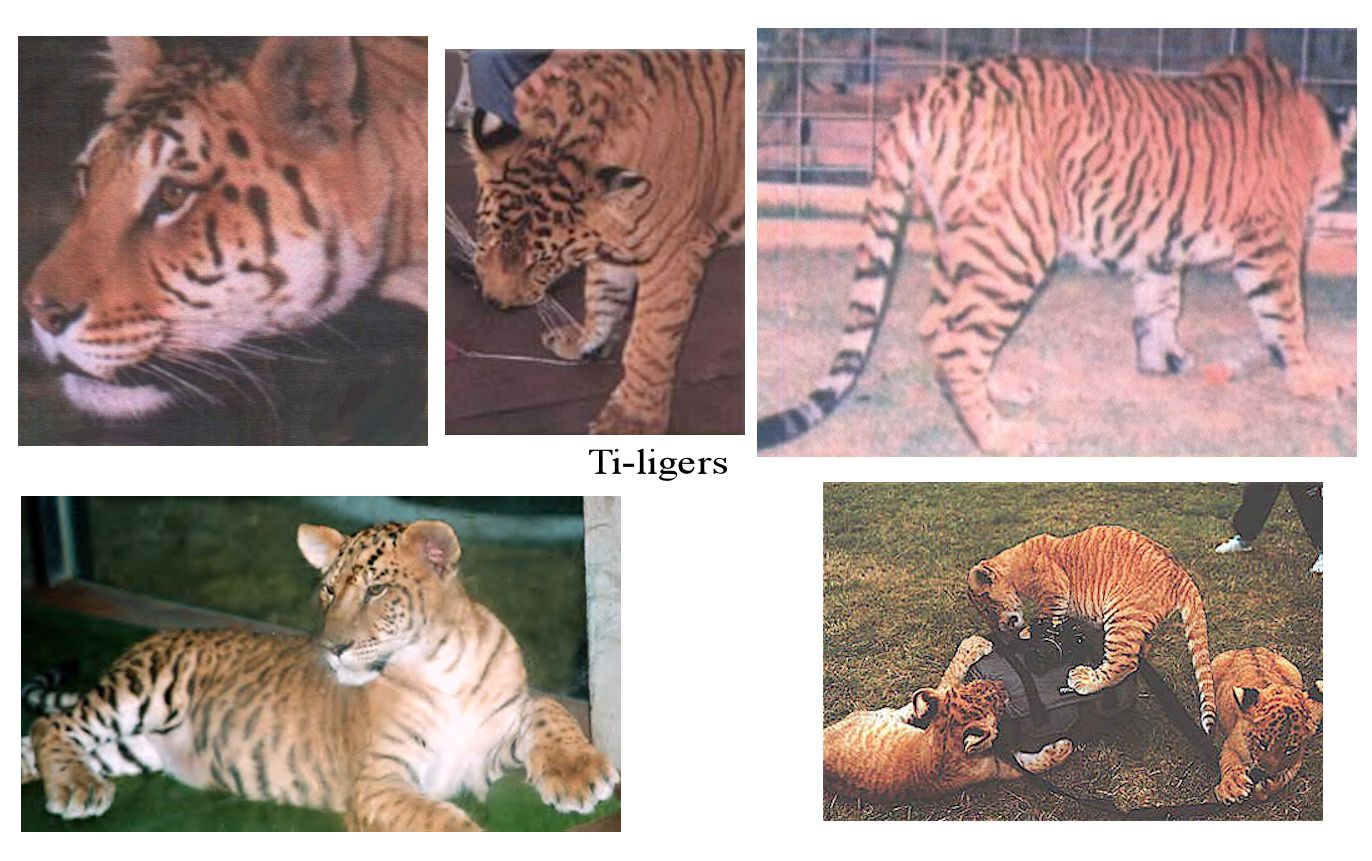
Turpentine Creek Wildlife Refuge had ti-liger Lakota (male). Valley of the Kings in Sharon, Wisconsin had a female ti-liger named Ti-ler.
Ti-ligers were born on 16th August 2007 at Garold Wayne Interactive Zoological Park in Wynnewood, Oklahoma. The first litter of tiligers were sired by white tiger Kahun on liger female Beauty. The five cubs were four males and one female: Tanyaro, Yun Yi, Monique, and two others no longer at Garold Wayne Interactive Zoological Park. On 7th March 2013, a litter of three ti-liger cubs were born at Garold Wayne Interactive Zoological Park, this time sired by Amur tiger Noah on a female liger called Lizzy.
|
Ti-liger |
Ligress Julie and her cub (either a ti-liger or li-liger - paternity was not stated). |
|
LIGER & TIGON COLOURS
White tigers have been crossed with lions to produce white ligers. Everland Zoo (Yongin Farm Zoo) in Seoul, Korea has produced white ligers, possibly from white tigers and leucistic lionesses. Big Cat Rescue's white tiger apparently co-habitates with a lion, as it was the intention of the original owner to breed white ligers. Golden tigers have been crossed with lions to produce golden ligers. In theory white tigers could be crossed with white lions to produce truly white ligers. White tigons or golden tigons are also possible, but because tigons do not attain the huge size of the liger there is far less interest in breeding them.
A black liger would be an impressive creature, but to breed one would require both a melanistic tiger and a melanistic lion because the gene for black must be inherited from both parents and to guarantee a black liger requires both parents to be black. Very few true melanistic tigers have ever been recorded. Most "black tigers" are due to pseudo-melanism i.e. the markings are so heavy that the tawny background colour is almost hidden. No reports of black lions have ever been substantiated.
In felines, "blue" means a slate-grey colour. Genetically, it is a form of melanism where the colour has been diluted from black to grey. To breed a blue liger would require a blue (i.e.grey) tiger and a black lion (or black tiger and blue lion. Or blue tiger and blue lion). Blue tigers have been recorded in China, but none have occurred in captivity. To date, no grey lions have been recorded.
Textual content is licensed under the GFDL.
|
BACK TO HYBRID & MUTANT BIG CATS INDEX |